
Year 13’s Muhammad Shah has won The Big Bang UK Young Technologist of the Year title for 2025.
 His winning project, Icarus, is a decentralised telecommunication system designed for low-cost and effective emergency communications in remote areas: it was inspired by his love of the outdoors and of trekking.
His winning project, Icarus, is a decentralised telecommunication system designed for low-cost and effective emergency communications in remote areas: it was inspired by his love of the outdoors and of trekking.
Muhammad was one of 11 QE pupils to reach the finals of The Big Bang Competition.
Mark Wood, Social Sustainability Lead at sponsor Siemens GB&I, said: “Muhammad stood out with his decentralised communication system, which avoids reliance on cellular or satellite networks and has great opportunities for search and rescue, leisure and other business uses.
“Muhammad demonstrated independent learning and great communication and presentation skills and is a worthy winner of the prize!”
The Big Bang Competition, run by the EngineeringUK charity, is open to young people in the UK aged 11-18 who are in state-funded education, are home-educated or who enter as part of a community group.
The Big Bang UK Young Technologist of the Year award recognises innovation in digital and sustainable technology. It highlights the importance of technology in various sectors, including search and rescue, leisure, and business.
Muhammad describes himself as an aspiring engineer who enjoys 3D printing, CAD modelling, printed circuit board (PCB) design and other electronics.
His project was inspired by the communication difficulties people experience in remote areas, and particularly by the need for better communication when people out trekking get into difficulty. Its decentralised approach avoids reliance on cellular or satellite networks.
With Muhammad unable to attend the Big Bang Fair at Birmingham’s NEC because of an A-level examination, the prize was instead presented at the School’s Technology Design Showcase by EngineeringUK’s Director of Communications, Beth Elgood, and Siemens’ General Manager and UK Country Lead, Hannah Winstanley. The two also agreed to serve on the judging panel at the QE event.
Tech spec: how Muhammad solved the problem
 Icarus uses a custom Meshtastic PCB based on ESP32-S3 N8R8, L76K GPS and LoRa RA-01SH, designed to be fully assembled by the online PCB service provider, JLCPCB.
Icarus uses a custom Meshtastic PCB based on ESP32-S3 N8R8, L76K GPS and LoRa RA-01SH, designed to be fully assembled by the online PCB service provider, JLCPCB.
Meshtastic is a decentralised, off-grid network that lets users send and receive messages using affordable, low-power devices. Icarus also makes use of LoRa, a long-range radio protocol, which is widely accessible in most regions without the need for additional licences or certifications (unlike HAM radio). These radios are designed to rebroadcast messages they receive, forming a network. This setup ensures that every group member, including those at the furthest distance, can receive messages.


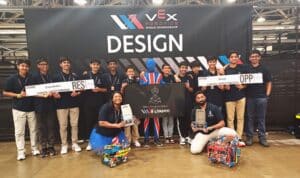 “In the VIQRC competition, too, our Year 9 teams, Omega and Constellation, shone very brightly. Omega secured the Build Award, recognising their robot’s outstanding construction and reliability, and Team Constellation added to QE’s growing trophy cabinet with another Design Award.”
“In the VIQRC competition, too, our Year 9 teams, Omega and Constellation, shone very brightly. Omega secured the Build Award, recognising their robot’s outstanding construction and reliability, and Team Constellation added to QE’s growing trophy cabinet with another Design Award.”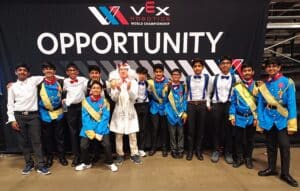 “But the best was yet to come,” said Mr Noonan. “Team Omega’s Build Award and Constellation’s Design Awards were fantastic achievements. As if that was not enough, both teams dazzled with their themed pit displays and costumes, winning the Costume Competition – a celebration of creativity and team spirit announced during the final rounds.”
“But the best was yet to come,” said Mr Noonan. “Team Omega’s Build Award and Constellation’s Design Awards were fantastic achievements. As if that was not enough, both teams dazzled with their themed pit displays and costumes, winning the Costume Competition – a celebration of creativity and team spirit announced during the final rounds.”

 Technology giant Intel asked Paarth to speak at the 2025 BETT UK after he took the national title in his age category in last year’s Intel AI Global Impact Festival. He won after impressing judges with his multi-lingual Navigate Ninja app, which uses storytelling and animated video to offer personalised learning to children with autism.
Technology giant Intel asked Paarth to speak at the 2025 BETT UK after he took the national title in his age category in last year’s Intel AI Global Impact Festival. He won after impressing judges with his multi-lingual Navigate Ninja app, which uses storytelling and animated video to offer personalised learning to children with autism. It was, he added, a “golden opportunity to exchange thoughts, ideas and suggestions with my fellow Intel presenters, technocrats, industry leaders, and renowned organisations”.
It was, he added, a “golden opportunity to exchange thoughts, ideas and suggestions with my fellow Intel presenters, technocrats, industry leaders, and renowned organisations”.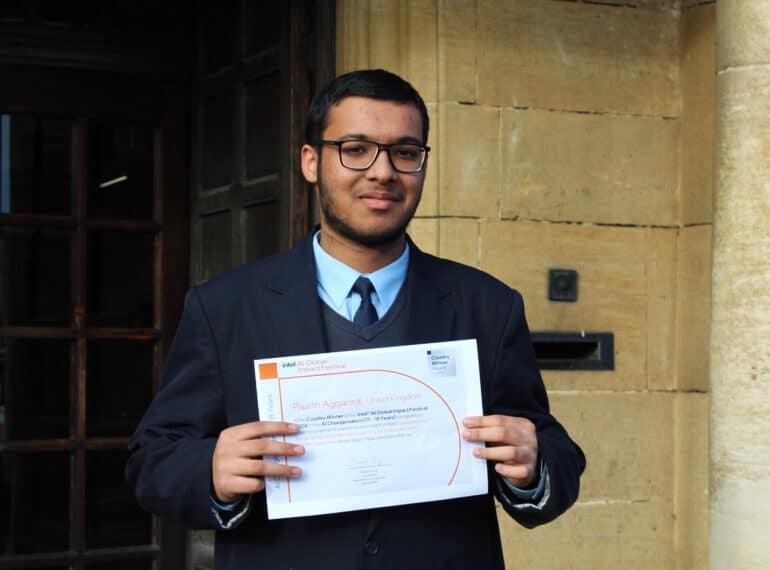
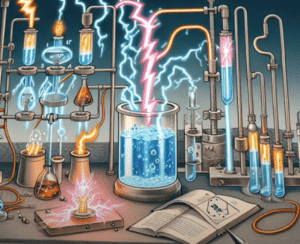 Parth took the national title in the AI Changemakers ages 13–18 category after impressing judges in the Intel AI Global Impact Festival 2024 with his multilingual GenAI-powered NavigateNinja app.
Parth took the national title in the AI Changemakers ages 13–18 category after impressing judges in the Intel AI Global Impact Festival 2024 with his multilingual GenAI-powered NavigateNinja app. He spent many hours researching, developing, and refining the project. His app provides unique content across different subjects, based on skill level; it aims to enhance comprehension and information retention.
He spent many hours researching, developing, and refining the project. His app provides unique content across different subjects, based on skill level; it aims to enhance comprehension and information retention.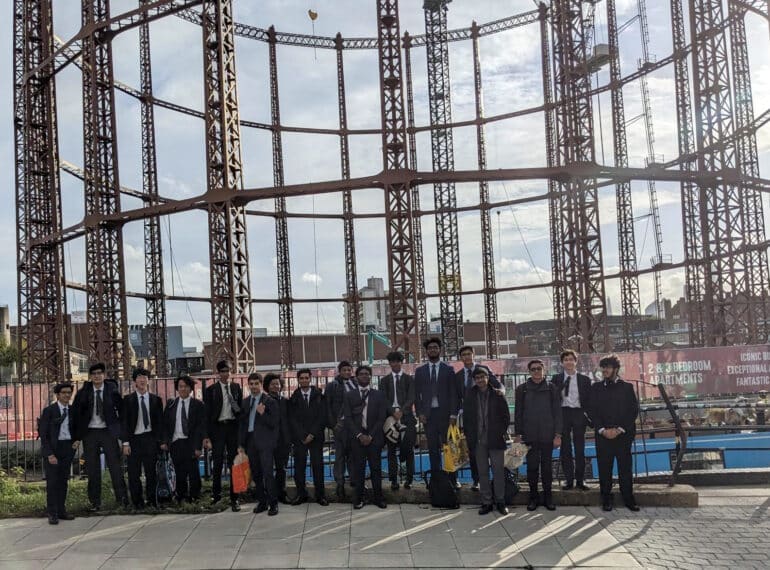
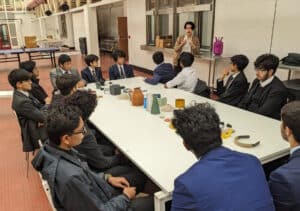 They learned how the company is pioneering a truly sustainable approach by recycling already-recycled materials to produce the plastic filament used by the printers.
They learned how the company is pioneering a truly sustainable approach by recycling already-recycled materials to produce the plastic filament used by the printers.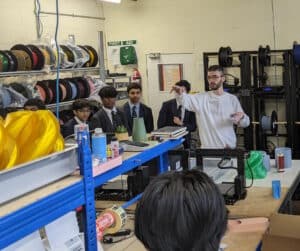 Recently awarded an innovation grant of £1.8m to create a network of manufacturing hubs that will use local recycled materials, Batch.Works is now investigating ‘urban mining’, the notion of turning waste streams into new products. It launched an equity crowdfunding campaign in September.
Recently awarded an innovation grant of £1.8m to create a network of manufacturing hubs that will use local recycled materials, Batch.Works is now investigating ‘urban mining’, the notion of turning waste streams into new products. It launched an equity crowdfunding campaign in September.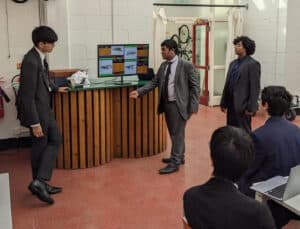 “Next, they were shown into the wildly impressive plant room by Dean and Liam,” said Mr Noonan. “The room contained 40 3D printers, some of which could print items as large as 1 metre square. Many of these were stacked on server cabinets, and the designers had impressively ‘hacked’ the G code [the most commonly used 3D-printing programming language] which drives the printers to turn them into automated 3D printing machines that could work around the clock. This means the rate at which the designers can prototype and manufacture is unrivalled.”
“Next, they were shown into the wildly impressive plant room by Dean and Liam,” said Mr Noonan. “The room contained 40 3D printers, some of which could print items as large as 1 metre square. Many of these were stacked on server cabinets, and the designers had impressively ‘hacked’ the G code [the most commonly used 3D-printing programming language] which drives the printers to turn them into automated 3D printing machines that could work around the clock. This means the rate at which the designers can prototype and manufacture is unrivalled.”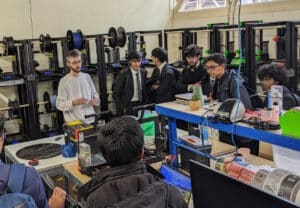 “It was at this point that the students began to ready themselves for their own presentations, as Liam had kindly agreed to take in the students’ presentations on their own recent vacuum cleaner projects. These, in fact, utilised many of the prototyping techniques with which he was familiar from his own studies in Product Design at the RCA and Central St Martins.”
“It was at this point that the students began to ready themselves for their own presentations, as Liam had kindly agreed to take in the students’ presentations on their own recent vacuum cleaner projects. These, in fact, utilised many of the prototyping techniques with which he was familiar from his own studies in Product Design at the RCA and Central St Martins.”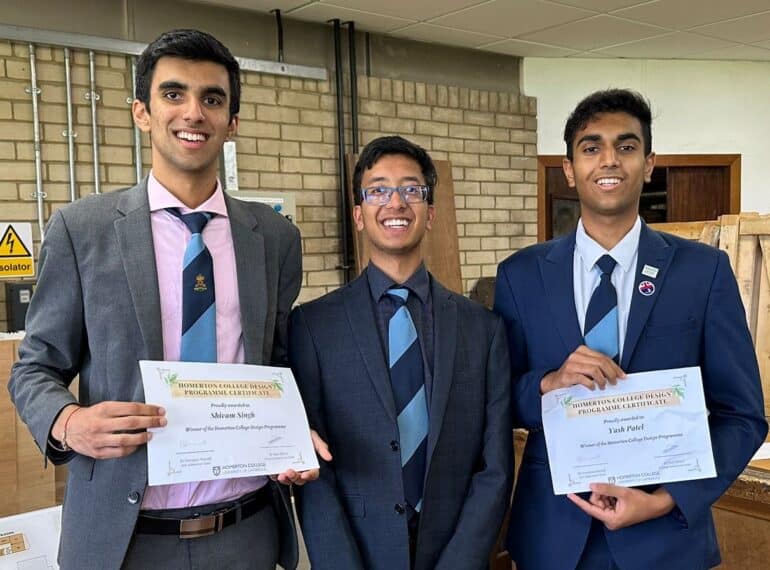
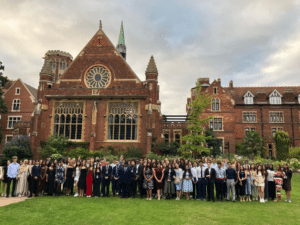 After being highly commended in the Homerton College Design Programme, Shivam Singh, Yash Patel and Om Patel were invited to a residential weekend, along with more than 200 other highly commended entrants of the design challenge and a parallel essay competition.
After being highly commended in the Homerton College Design Programme, Shivam Singh, Yash Patel and Om Patel were invited to a residential weekend, along with more than 200 other highly commended entrants of the design challenge and a parallel essay competition.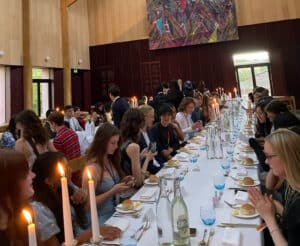 The QE trio, who are now in Year 13, designed a speaker to reduce noise pollution caused by machinery in the construction industry.
The QE trio, who are now in Year 13, designed a speaker to reduce noise pollution caused by machinery in the construction industry.